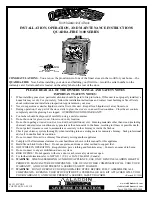
AREAS FOR ROUTINE INSPECTION
The following should be inspected periodically to ensure that the appliance is operating at its optimum and giving
you excellent heat value:
2-3 DAYS/WEEKLY
SEASONALLY or 2 TONS OF FUEL
Burn Pot and Liner
Exhaust Vent and Fresh Air Intake Tube
Ash Pan
Blower Mechanisms
Inside Firebox
Heat exchanger tubes
Behind Firebox Liners
Latch Mechanism of ash pan
Door Glass
Door Latch
Heat exchanger tubes
All Hinges
Ash pan and Door gaskets
Post Season Clean-up
TOOLS REQUIRED TO CLEAN UNIT:
. Torx T-20 Screwdriver, 5/16 Socket and Ratchet, Brush, Soft
Cloth, Vacuum with fine filter bag
ASH PAN AND DOOR GASKETS
After excessive use the gasketing may come loose. To repair this, glue the gasketing on using high-temperature
fiberglass gasket glue available from your local dealer. This is important to maintain an airtight assembly.
DO
NOT PLACE UNBURNED OR RAW PELLET FUEL IN ASH PAN.
BURNER POT AND LINER
This is the ‘pot’ where the pellets are burned. Every two to three days (when the unit is cold) remove the burn-pot
liner from the stove. Using a metal scrapper remove material that has accumulated or is clogging the liner’s
holes. Then dispose of the scrapped ashes from the liner and from inside the burn-pot. Place the burn-pot back
into the stove, making sure that the pipes are properly inserted into the burn pot and the front tabs are in place in
the firebox. Place the liner back into the burn-pot, making sure that the ignitor hole in the liner is aligned with the
ignitor tube. Pushing the liner up against the igniter tube.
To remove the burn pot and burn pot liner open the door using the door handle provided located on the left-hand
side of the stove, swing the door open. Lift the liner from the burn pot, lift the burn pot from the firebox by gently
lifting the front of the burn pot up first then sliding the assembly from the air intake tube and the igniter cartridge.
FRESH AIR
TUBE
BURN POT
BURN POT
LINER
IGNITER TUBE
INSERT ASH REMOVAL:
The EF 3 pellet stove insert does not have an ash pan and the ashes must be vacuumed out of the firebox on a
daily basis.
CAUTION: BECAUSE THE FLY ASH IS VERY FINE, THE USE OF A VACUUM BAG WILL BE
REQUIRED TO PREVENT ASH FROM BEING BLOWN BACK INTO THE ROOM.
Please pay special attention
that there are no hot ashes in the firebox or there could be a possibility of a fire hazard inside the vacuum cleaner.
Place all hot ashes into a noncombustible container.
FREESTANDING ASH PAN:
This part is located under the burner, in the pedestal and has a latching mechanism to secure it. To remove the
ash pan, unlock the latch on the pedestal cover and then pull the pan out. Dump the ashes into a metal container
stored away from combustibles. Monitor the ash level every week
. Remember that different pellet fuels will
have different ash contents.
Ash content is a good indication of fuel efficiency and quality. Refer to “Warnings
and Recommendations” for disposal of ashes.
BLOWER MECHANISMS
Unplug the stove then open the right/left side panels to access the two blowers. Only the convection blower
motor (on the right side of the stove) will require lubrication. The convection motor has two lubrication holes on it.
Use two drops of SAE 20, light oil to lubricate every six months. Excess oil may damage the motor. The exhaust
blower’s motor has sealed bearings, DO NOT lubricate this motor.
8
Содержание EF-III BAY I BIH
Страница 20: ...THROUGH WALL INSTALLATION 1 20...
Страница 27: ...WIRING DIAGRAM 27...









































